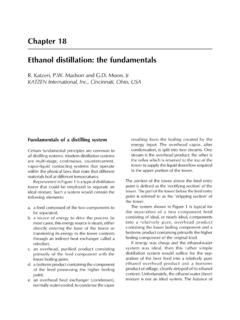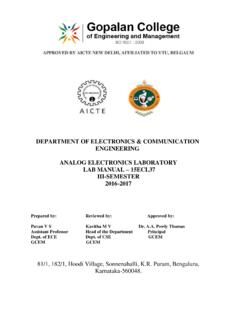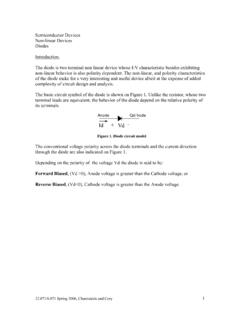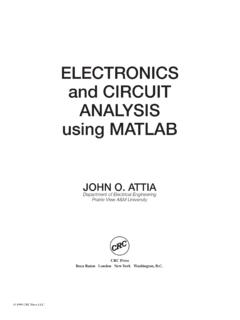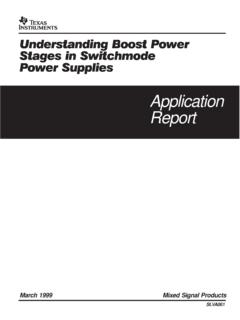Transcription of Techno-economic Analysis of PEM Electrolysis for …
1 Techno-economic Analysis of PEM Electrolysis for Hydrogen Production Strategic Analysis Inc. Whitney G. Colella Brian D. James Jennie M. Moton NREL. Genevieve Saur Todd Ramsden Electrolytic Hydrogen Production Workshop NREL, Golden, Colorado 27 February 2014. Introduction and Purpose Analyze H2 Production & Delivery (P&D) pathways to determine the most economical, environmentally-benign, and societally- feasible paths forward for the production and delivery of H2 fuel for fuel cell vehicles (FCVs). Identify key bottlenecks to the success of these pathways, primary cost drivers, and remaining R&D challenges.
2 Assess technical progress, hydrogen costs, benefits and limitations, and the potential to meet DOE P&D cost goals of $2 to 4/gasoline gallon equivalent (gge) (dispensed, untaxed) by 2020. Analyses assist DOE in setting research direction & priorities. H2A Production Model is used as the primary Analysis tool for projection of $/kgH2 production costs and cost sensitivities. 2 2. Technical Approach 1. Select technology pathway 2. Collect information from Researchers/Developers System configuration details System performance Emissions Technical status All other relevant issues, concerns, shortfalls 3.
3 Conduct Techno-economic Analysis System definition Develop mass and energy balance models, where appropriate Define system Bill of Materials Estimate capital costs Define system performance parameters feedstock/energy consumption rates labor, equipment lifetime, replacement schedule, etc. System performance Analysis 4. Model system in DOE's H2A H2 Production Cost model 5. Initial results vetted with researchers/developers/DOE. 6. Conduct sensitivity Analysis based on feedback 7. Repeat steps 2-5 until team is confident in results 3 3. Overview of H2A Model Results Standard Price and Property Data Cost Analysis Production Information Cost + Rate of Feedstock and Financial Cost Replacement Return Utility Prices Description Inputs Inputs Costs Cost Contribution Physical Title Performance Process Stream Property Data Assumptions Flowchart Summary Sensitivity Analysis Technical Analysis Key Cost Drivers H2A is a discounted cash flow Analysis that computes the required price of H2 for a desired after-tax internal rate of return (IRR).
4 Developed by NREL and DOE EERE-FCTO. Objective of H2A Analyses (production): Establish a standard format for reporting the production cost of H2, so as to compare technologies and case studies Provide transparent Analysis Provide consistent approach Prioritize research and development efforts 4. 4. Different Technologies Analyzed using H2A. Past Production Case Studies Existing Technologies Emerging Technologies Natural Gas Steam Methane Reforming (SMR) Photoelectrochemical (PEC) (Central). (Central/Forecourt) Photo-Biological H2 (Central). Electrolysis (Central/Forecourt) Solar Thermochemical H2 (STCH) (Central).
5 Ethanol Reforming (Forecourt). Biomass (Central). Coal Gasification (Central). Nuclear Powered Water Splitting (Central). All production cases above can be found at: Next Generation of Pathway-Dependent Production Case Studies being Developed 5 5. Hydrogen Production from Natural Gas: Bridge to Longer-Term, Low-Carbon Technologies Distributed H2 Production from Projected $/kg H2 (produced & untaxed, today's technology) for Varying Natural Gas NG SMR (high volume/economies Spot Prices in line with market production costs of scale, 1500 kg/day production). Cost of H2 production not limiting factor Cost goals can be met by a wide range of NG prices*.
6 Focus shifting to longer term, renewable pathways: o Bio-feedstocks feedstock cost/availability o Renewable Electrolysis renewable electricity cost o Emerging Technologies *Production Cost Using Low-Cost Based on H2A v3 Case Studies @ Natural Gas, September, 2012, AEO2009 avg NG prices (HHV, $/MMBtu): $ (Current, 2010-2030); $ (Future, 2020-2040). AEO2012 avg NG prices (HHV, $/MMBtu): $ (Current, 2010-2030); $ (Future, 2020-2040). 6 6. Case Overview Investigation of H2 production using a standalone grid-powered Polymer Electrolyte Membrane (PEM) Electrolyzer Four cases developed using the H2A v3 tool (for high volume projections of H2.)
7 Production costs incorporating economies of scale) : Plant Start Production of H2. Case Plant Life (years). Date (kilograms (kg)/day). Current Forecourt 2010 1,500 20. Future Forecourt 2025 1,500 20. Current Central 2010 50,000 40. Future Central 2025 50,000 40. Existing Case ( if you were fabricating today at current volume ). Similar to performance & price quotes available now. Analyzed but not discussed here. Current Case ( if you were fabricating today at production volume )*. Demonstrated advances in technology are implemented Potential reduction in capital cost from existing values Plant lifetimes consistent with measured or reported data Future Case New materials and systems with increased H2 production efficiency and longer plant lifetimes Improved replacement cost schedule Greater reductions in capital cost 7 *not to be confused with existing costs based on low production commercially available electrolyzers 7.
8 PEM Electrolysis Technology Power Supply PEM water Electrolysis uses electrical power to split water into oxygen (O2) and hydrogen (H2). 4 e- 4 e- Positive terminal (anode): water (H2O) reacts with Polymer catalyst to form oxygen molecules, electrons (e-), O2 Electrolyte Cathode (-). and hydrogen protons (H+). Anode (+). Membrane 2 H2 Electrolyte: Hydrogen protons are conducted across the polymer electrolyte membrane. 4 H+. External Circuit: electrons flow through an external 2 H2O power supply to produce an electric current. 2H2O 4H+ + 4e- + O2 4 H+ + 4 e- 2 H2 Negative terminal (cathode): the electrons combine with the hydrogen protons to produce H2.
9 Hydrogen Production System design Oxygen Gas Oxygen Gas Water Reactant Delivery (generated but Management currently modeled Purified Management System System as being released Process into the atmosphere). Water Power Electronics: Electrolyzer Hydrogen Gas AC/DC Transformer Management Hydrogen Stacks with System Gas Grid And rectifier Controller and Power Sensors 8 8. Key Analysis Modeling Assumptions and Basis for Assumptions Summary: PEM Electrolysis H2A case models based on a generic system using input from several key industry collaborators with commercial experience in PEM Electrolysis .
10 Methodology: Solicited information from four electrolyzer companies Requested relevant detailed information on: Current/Future cases for Forecourt/Central Followed H2A sheet input format: System definition Capital costs Operating conditions Replacement costs Variable and fixed expenses Data synthesized, amalgamated into base parameters for cases Base parameters & sensitivity limits vetted by the four companies Four H2A Cases Populated and models run to predict H2 cost Current/Future cases for Forecourt/Central Production 9 9. Basic Parameters Used for the Four Public H2A Cases Forecourt Central Current Future Current Future Technical Parameters Production Equipment Availability Factor (%) 97% 97% 97% 97%.










